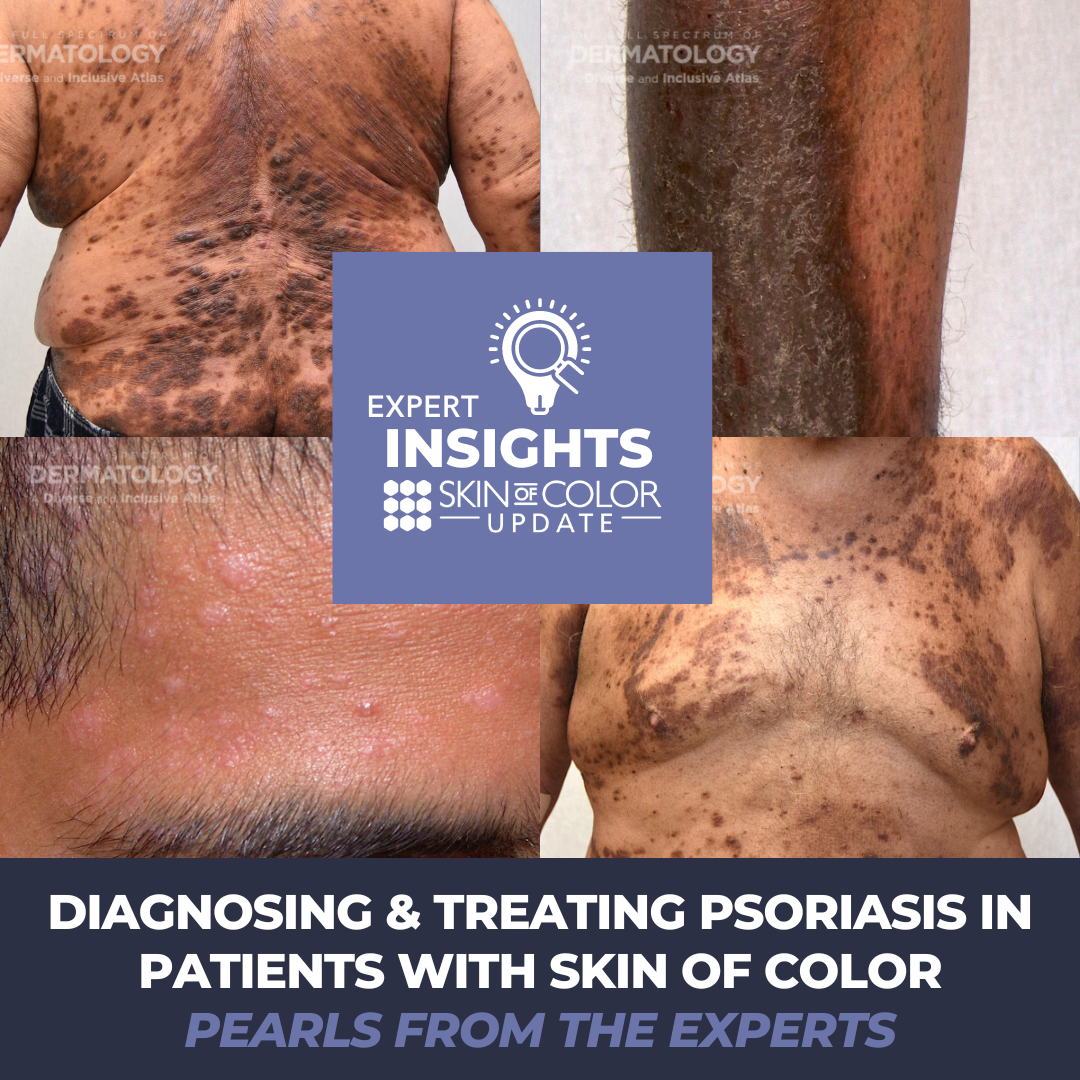During the 2023 Skin of Color Update in New York City, esteemed experts, Dr. Andrew Alexis, Professor of Clinical Dermatology at Weill Cornell Medical College, and Dr. George Han, Associate Professor in the Department of Dermatology at the Donald and Barbara Zucker School of Medicine at Hofstra/Northwell, shared their expertise in diagnosing and managing psoriasis in individuals with skin of color. The broad range in presentation of psoriasis in skin of color has only recently gained attention and may have played a crucial role in potential underdiagnosis and delays in administering appropriate treatment. This article will explore pearls from their discussion as well as insights into the challenges of recognizing and treating psoriasis in individuals with diverse ethnic backgrounds.
Epidemiologic Data:
Historically, textbooks portrayed psoriasis as rare in patients of color, especially those of African descent. However, newer epidemiologic data challenges this, showing a prevalence of 1.9% in African Americans, 1.6% in Hispanic or Latinx individuals, and 1.4% in other non-white populations.1
Clinical Presentation:
Psoriasis manifests as pink scaly plaques in light skin tones and may take on a distinct violaceous-grey appearance in individuals with darker skin tones. Recognizing the variations in erythema associated with psoriasis in patients with skin of color is important. Dr. Alexis and Dr. Han illustrated these variations, showcasing examples of erythema manifesting with hues from violaceous to violaceous-grey and reddish-brown, while maintaining the classic micaceous quality of psoriasis scale. Addressing pigment alterations, involving both hypo- and hyperpigmentation, adds complexity to treating inflammatory skin diseases like psoriasis in skin of color.
Impact of Psoriasis on Health-Related Quality of Life:
Dr. Alexis was involved in a recent study revealing that Black, Asian, and Hispanic or Latino patients report a greater impact of psoriasis on their health-related quality of life compared to white patients.2 Not only is the impact of psoriasis greater in minority patients, but this population is also less likely seek care.1 This recognition highlights the need for tailored and inclusive approaches in psoriasis management.
Scalp psoriasis, particularly in women of African descent, poses an additional burden and challenge. Factors such as lower hair washing frequency and diverse haircare practices impact treatment choices. The cultural implications of visible scalp scaling add an additional layer of complexity.
Differential Diagnoses:
It is important to consider differential diagnoses, especially when one is presented with scaly skin conditions. Psoriasis mimickers can include cutaneous T-cell lymphoma, sarcoidosis, and the hypertrophic variant of discoid lupus. Clinical diagnosis remains crucial, but biopsies may be necessary in cases that do not fit the classical presentation of psoriasis.
Pathophysiologic Differences:
Dr. Han noted that there are fundamental pathophysiologic differences that may drive the clinical presentation, severity, and response to treatment of psoriasis in patients with skin of color. Supporting this, a study revealed heightened Th1 cytokines and C-reactive protein levels in the atopic skin of African American and Hispanic or Latino patients, indicators of increased systemic inflammation compared to Caucasian patients.3 Another study demonstrated intrinsic pro-inflammatory signaling in healthy African American skin through transcriptomic analysis.4 Many of these upregulated genes play a direct role in the pathophysiology of psoriasis. Interestingly, out of the 570 differentially expressed genes seen in African American skin, only four genes were pigmentation related demonstrating that pigment alone plays a small role. These pro-inflammatory skin profiles may also contribute to comorbidities associated with psoriasis.
Treatment Considerations:
The unique pro-inflammatory gene-expression profile in African American skin may influence the response of African American skin to treatments. Dr. Han discussed the differential effects of topical corticosteroids on African American and Caucasian skin. One study found that application of topical clobetasol led to a greater treatment response in African American skin compared to Caucasian skin.5 Thus, a nuanced approach to systemic therapy may be needed, recognizing the inflammatory state inherent to different skin types.
In conclusion, insights from Dr. Alexis and Dr. Han stress the importance of tailored psoriasis management in patients of color. Understanding clinical variations, treatment responses, and impact on quality of life is vital for effective care, urging an attitude shift towards early intervention and improved patient outcomes.
References:
-
- Alexis, A. F., & Blackcloud, P. (2014). Psoriasis in skin of color: epidemiology, genetics, clinical presentation, and treatment nuances. The Journal of clinical and aesthetic dermatology, 7(11), 16–24.
- Takeshita, J., Augustin, M., de Jong, E. M. G. J., Lafferty, K. P., Langholff, W., Langley, R. G., Menter, A., & Alexis, A. F. (2022). Health-Related QOL Differs by Race/Ethnicity in North American Patients with Psoriasis: Results from PSOLAR. The Journal of investigative dermatology, 142(9), 2528–2531.e3. https://doi.org/10.1016/j.jid.2022.02.013
- Nomura, T., Wu, J., Kabashima, K., & Guttman-Yassky, E. (2020). Endophenotypic Variations of Atopic Dermatitis by Age, Race, and Ethnicity. The journal of allergy and clinical immunology. In practice, 8(6), 1840–1852. https://doi.org/10.1016/j.jaip.2020.02.022
- Klopot, A., Baida, G., Kel, A., Tsoi, L. C., Perez White, B. E., & Budunova, I. (2022). Transcriptome Analysis Reveals Intrinsic Proinflammatory Signaling in Healthy African American Skin. The Journal of investigative dermatology, 142(5), 1360–1371.e15. https://doi.org/10.1016/j.jid.2021.09.031
- Lili, L. N., Klopot, A., Readhead, B., Baida, G., Dudley, J. T., & Budunova, I. (2019). Transcriptomic Network Interactions in Human Skin Treated with Topical Glucocorticoid Clobetasol Propionate. The Journal of investigative dermatology, 139(11), 2281–2291. https://doi.org/10.1016/j.jid.2019.04.021
This information was presented by Drs. Andrew Alexis and George Han during the 2023 Skin of Color Update conference. The above highlights from their lecture were written and compiled by Dr. Sarah Millan.
Did you enjoy this article? You can find more on Medical Dermatology here.

